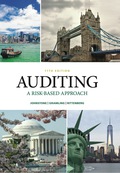
EBK AUDITING: A RISK BASED-APPROACH
11th Edition
ISBN: 9781337670203
Author: RITTENBERG
Publisher: YUZU
expand_more
expand_more
format_list_bulleted
Question
Chapter 9, Problem 27CYBK
To determine
Introduction:
Auditing involves scrutiny of account books and other involved records to test the fair representation by the company of its financial position.
To select:
Choose the statement that represents true view of the given condition.
Expert Solution & Answer
Want to see the full answer?
Check out a sample textbook solution
Students have asked these similar questions
Don't use ai given answer accounting questions
Answer? ? General Accounting
Find out answer
Chapter 9 Solutions
EBK AUDITING: A RISK BASED-APPROACH
Ch. 9 - In the revenue cycle, the most significant...Ch. 9 - Which of the following statements is true...Ch. 9 - Prob. 4CYBKCh. 9 - Prob. 7CYBKCh. 9 - Prob. 8CYBKCh. 9 - Prob. 9CYBKCh. 9 - Prob. 10CYBKCh. 9 - Prob. 11CYBKCh. 9 - Prob. 12CYBKCh. 9 - Prob. 13CYBK
Ch. 9 - Prob. 14CYBKCh. 9 - Prob. 15CYBKCh. 9 - Prob. 16CYBKCh. 9 - Prob. 17CYBKCh. 9 - Prob. 18CYBKCh. 9 - Which of the following statements is false...Ch. 9 - Prob. 20CYBKCh. 9 - Prob. 22CYBKCh. 9 - Prob. 23CYBKCh. 9 - Prob. 24CYBKCh. 9 - Prob. 25CYBKCh. 9 - Prob. 26CYBKCh. 9 - Prob. 27CYBKCh. 9 - Prob. 28CYBKCh. 9 - Prob. 29CYBKCh. 9 - Prob. 30CYBKCh. 9 - Prob. 31CYBKCh. 9 - Prob. 32CYBKCh. 9 - Refer to Exhibit 9.1. Which accounts are relevant...Ch. 9 - Prob. 2RQSCCh. 9 - Prob. 3RQSCCh. 9 - An important task ¡n the audit of the revenue...Ch. 9 - Prob. 5RQSCCh. 9 - Prob. 6RQSCCh. 9 - Prob. 7RQSCCh. 9 - Prob. 8RQSCCh. 9 - Prob. 9RQSCCh. 9 - Prob. 10RQSCCh. 9 - Prob. 11RQSCCh. 9 - Prob. 12RQSCCh. 9 - Prob. 13RQSCCh. 9 - Prob. 14RQSCCh. 9 - Prob. 15RQSCCh. 9 - Stainless Steel Specialties (SSS) is a...Ch. 9 - Prob. 17RQSCCh. 9 - Prob. 18RQSCCh. 9 - Prob. 19RQSCCh. 9 - Prob. 20RQSCCh. 9 - Prob. 21RQSCCh. 9 - Prob. 22RQSCCh. 9 - Prob. 23RQSCCh. 9 - Prob. 24RQSCCh. 9 - Prob. 25RQSCCh. 9 - Prob. 26RQSCCh. 9 - Prob. 27RQSCCh. 9 - Prob. 28RQSCCh. 9 - Prob. 29RQSCCh. 9 - Prob. 30RQSCCh. 9 - Prob. 31RQSCCh. 9 - Prob. 32RQSCCh. 9 - Prob. 33RQSCCh. 9 - Prob. 34RQSCCh. 9 - Prob. 35RQSCCh. 9 - Prob. 36RQSCCh. 9 - Prob. 37RQSCCh. 9 - Prob. 38RQSCCh. 9 - Prob. 39RQSCCh. 9 - Read the following scenario about Strang...Ch. 9 - Prob. 41RQSCCh. 9 - Prob. 42RQSCCh. 9 - ZYNGA (LO Z 3, 4, 5, 6, 8) Refer to the Why It...Ch. 9 - UTSTARCOM, INC. (LO 2, 3, 4, 5, 6, 8) UTStarcom is...Ch. 9 - Prob. 47FFCh. 9 - Prob. 48FFCh. 9 - Prob. 55DAUA
Knowledge Booster
Similar questions
- I won't to this question answer general Accountingarrow_forwardHello tutor give me solutionarrow_forwardAKA works in an accounts payable department of a major retailer. She has attempted to convince her boss to take the discount on the 3 / 25 net 90 credit terms most suppliers offer, but her boss argues that giving up the 7% discount is less costly than a short-term loan at 9%. Prove to whoever is wrong that the other is correct. (Note: Assume a 365-day year.) The cost of giving up the cash discount is %. (round to two decimal places). Give solution to this financial accounting Problem.arrow_forward
- If Rohan Inc., has an equity multiplier of 1.76, total asset turnover of 1.78, and a profit margin of 9.50 percent. What is its ROE? Answer this financial accounting problem.arrow_forwardHi expert please give me answer general accounting questionarrow_forwardBefore prorating the manufacturing overhead costs at the end of 2016..arrow_forward
arrow_back_ios
SEE MORE QUESTIONS
arrow_forward_ios
Recommended textbooks for you
 Auditing: A Risk Based-Approach (MindTap Course L...AccountingISBN:9781337619455Author:Karla M Johnstone, Audrey A. Gramling, Larry E. RittenbergPublisher:Cengage Learning
Auditing: A Risk Based-Approach (MindTap Course L...AccountingISBN:9781337619455Author:Karla M Johnstone, Audrey A. Gramling, Larry E. RittenbergPublisher:Cengage Learning Auditing: A Risk Based-Approach to Conducting a Q...AccountingISBN:9781305080577Author:Karla M Johnstone, Audrey A. Gramling, Larry E. RittenbergPublisher:South-Western College Pub
Auditing: A Risk Based-Approach to Conducting a Q...AccountingISBN:9781305080577Author:Karla M Johnstone, Audrey A. Gramling, Larry E. RittenbergPublisher:South-Western College Pub

Auditing: A Risk Based-Approach (MindTap Course L...
Accounting
ISBN:9781337619455
Author:Karla M Johnstone, Audrey A. Gramling, Larry E. Rittenberg
Publisher:Cengage Learning

Auditing: A Risk Based-Approach to Conducting a Q...
Accounting
ISBN:9781305080577
Author:Karla M Johnstone, Audrey A. Gramling, Larry E. Rittenberg
Publisher:South-Western College Pub
